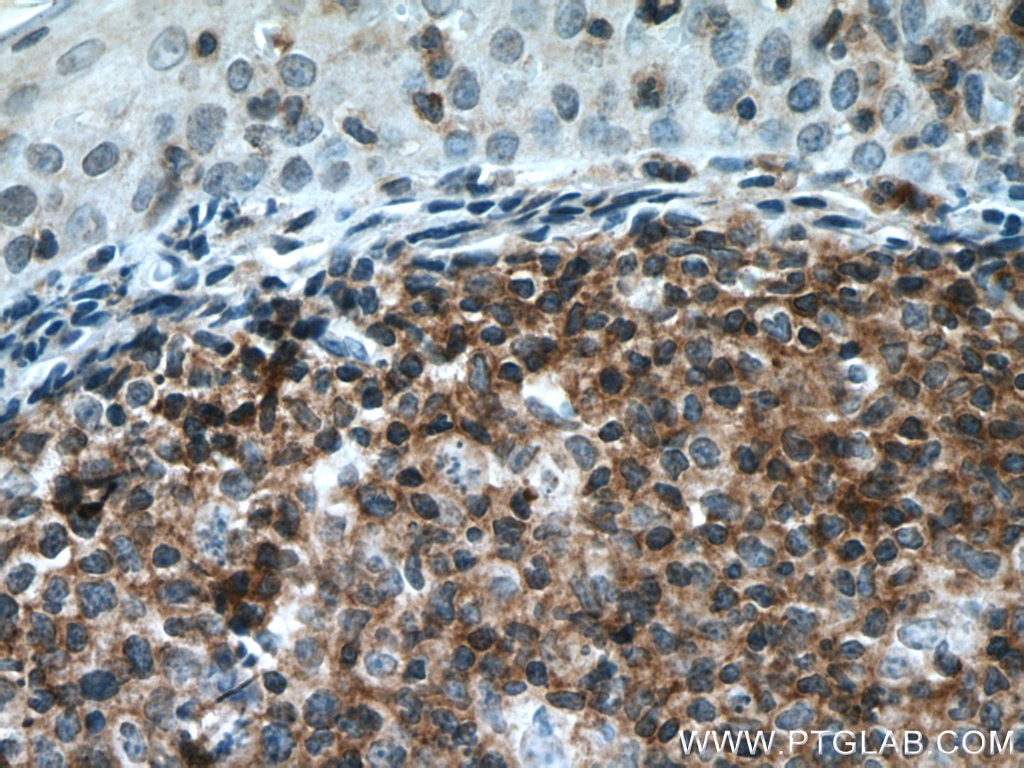Tested Applications
| Positive WB detected in | MOLT-4 cells, NK-92 cells, Jurkat cells |
| Positive IHC detected in | human tonsillitis tissue Note: suggested antigen retrieval with TE buffer pH 9.0; (*) Alternatively, antigen retrieval may be performed with citrate buffer pH 6.0 |
Recommended dilution
| Application | Dilution |
|---|---|
| Western Blot (WB) | WB : 1:1000-1:4000 |
| Immunohistochemistry (IHC) | IHC : 1:50-1:500 |
| It is recommended that this reagent should be titrated in each testing system to obtain optimal results. | |
| Sample-dependent, Check data in validation data gallery. | |
Product Information
21448-1-AP targets PVRIG in WB, IHC, ELISA applications and shows reactivity with human samples.
| Tested Reactivity | human |
| Host / Isotype | Rabbit / IgG |
| Class | Polyclonal |
| Type | Antibody |
| Immunogen |
CatNo: Ag13815 Product name: Recombinant human PVRIG protein Source: e coli.-derived, PET28a Tag: 6*His Domain: 193-326 aa of BC001129 Sequence: LRRHKHRPAPRLQPSRTSPQAPRARAWAPSQASQAALHVPYATINTSCRPATLDTAHPHGGPSWWASLPTHAAHRPQGPAAWASTPIPARGSFVSVENGLYAQAGERPPHTGPGLTLFPDPRGPRAMEGPLGVR Predict reactive species |
| Full Name | poliovirus receptor related immunoglobulin domain containing |
| Calculated Molecular Weight | 326 aa, 34 kDa |
| Observed Molecular Weight | ~34 kDa |
| GenBank Accession Number | BC001129 |
| Gene Symbol | PVRIG |
| Gene ID (NCBI) | 79037 |
| RRID | AB_2878859 |
| Conjugate | Unconjugated |
| Form | Liquid |
| Purification Method | Antigen affinity purification |
| UNIPROT ID | Q6DKI7 |
| Storage Buffer | PBS with 0.02% sodium azide and 50% glycerol, pH 7.3. |
| Storage Conditions | Store at -20°C. Stable for one year after shipment. Aliquoting is unnecessary for -20oC storage. 20ul sizes contain 0.1% BSA. |
Background Information
PVRIG, also named as CD112R and C7orf15, is an immune suppressive molecule expressed on T and NK cells. It's a cell surface receptor for NECTIN2. PVRIG is a target for the treatment of cancer.
Protocols
| Product Specific Protocols | |
|---|---|
| IHC protocol for PVRIG antibody 21448-1-AP | Download protocol |
| WB protocol for PVRIG antibody 21448-1-AP | Download protocol |
| Standard Protocols | |
|---|---|
| Click here to view our Standard Protocols |










